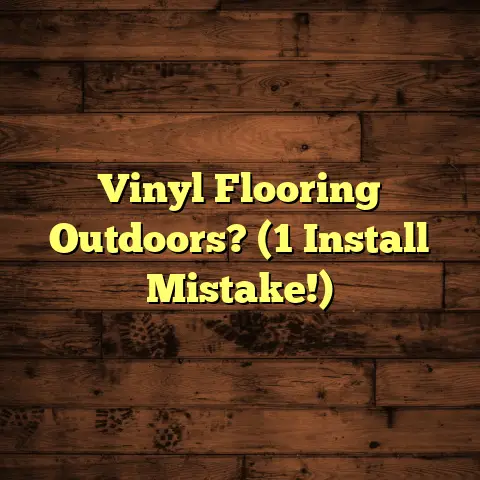Leveling Old Concrete Floors (DIY or Pro?)
Imagine stepping into your home after a long day, only to be greeted by the uneven, cracked concrete floor that echoes the wear and tear of time.
Each step feels like a reminder of the neglect your beloved space has endured, tugging at your heartstrings and igniting a desire for transformation.
The vision of a smooth, level floor that reflects your style and comfort may seem like a distant dream. But what if you could bring that dream to life?
In this article, we will explore the complexities of leveling old concrete floors, weighing the pros and cons of taking on the project yourself versus hiring a professional.
Section 1: Understanding the Importance of
Leveling Concrete Floors
Uneven concrete floors are more than just an eyesore. They can seriously impact your daily life. I’ve seen it firsthand, and honestly, it’s something you want to address sooner rather than later.
Think about it: tripping hazards, furniture that rocks and wobbles, and a general sense of unease every time you walk through a room. It’s not ideal, right?
Beyond the immediate inconveniences, there are long-term benefits to leveling your floors. A level floor improves safety, prevents damage to your furniture, and significantly enhances the aesthetic appeal of your home.
Plus, it can increase your property value. Who doesn’t want that?
Here’s a quick rundown of the benefits:
- Safety: Eliminates tripping hazards.
- Aesthetics: Creates a visually appealing and uniform surface.
- Furniture Protection: Prevents furniture from wobbling and breaking.
- Property Value: Increases the overall value of your home.
- Comfort: Improves the overall comfort and livability of your space.
Section 2: Common Causes of Uneven Concrete
Floors
So, what causes concrete floors to become uneven in the first place? It’s usually a combination of factors, and understanding these can help you prevent future problems.
One of the biggest culprits is soil settlement. Over time, the soil beneath your concrete slab can shift and compact, leading to cracks and unevenness.
Water damage is another major factor. Excessive moisture can erode the soil, causing the concrete to sink or heave.
And let’s not forget poor installation practices. If the concrete wasn’t properly poured or cured initially, it’s more likely to develop problems down the road.
Let me share a couple of case studies from my own experience:
- Case Study 1: The Sinking Slab I worked on a house where the concrete floor in the living room had sunk several inches on one side. It turned out that a leaky pipe had been slowly eroding the soil beneath the slab for years.
- Case Study 2: The Cracked Foundation In another case, a homeowner had significant cracking and unevenness throughout their basement floor. The culprit? Poor soil compaction during the initial construction of the house.
Here’s a table summarizing the common causes:
| Cause | Description |
|---|---|
| Soil Settlement | Shifting and compaction of soil beneath the slab over time. |
| Water Damage | Erosion of soil due to excessive moisture from leaks or flooding. |
| Poor Installation | Improper pouring, curing, or compaction during the initial construction process. |
| Tree Roots | Growing roots can lift and crack concrete. |
| Seismic Activity | Earthquakes and minor tremors can cause shifts and cracks. |
Section 3: DIY Leveling Methodologies
Okay, so you’ve got an uneven concrete floor. Now what? Well, you have a couple of options: DIY it or call in the pros. Let’s start with the DIY route.
There are a few popular methods for leveling concrete floors yourself. The most common are using self-leveling compounds and concrete overlays.
Self-Leveling Compounds
Self-leveling compounds are cement-based mixtures that you pour onto the floor. They spread out and level themselves, filling in low spots and creating a smooth, even surface.
Here’s a step-by-step guide:
- Prepare the Surface: Clean the floor thoroughly, removing any dirt, debris, or loose concrete.
- Prime the Floor: Apply a concrete primer to improve adhesion of the self-leveling compound.
- Mix the Compound: Follow the manufacturer’s instructions carefully when mixing the self-leveling compound.
- Pour and Spread: Pour the mixture onto the floor, starting in the deepest areas. Use a gauge rake to spread the compound evenly.
- Allow to Cure: Let the compound cure completely according to the manufacturer’s instructions.
Concrete Overlays
Concrete overlays are thin layers of concrete that you apply over the existing floor. They’re a good option for floors with minor imperfections or surface damage.
Here’s the process:
- Clean and Prep: Clean the floor thoroughly and repair any cracks or holes.
- Apply Bonding Agent: Apply a bonding agent to help the overlay adhere to the existing concrete.
- Mix the Overlay: Mix the concrete overlay according to the manufacturer’s instructions.
- Apply the Overlay: Apply the overlay with a trowel, creating a smooth, even surface.
- Cure and Seal: Allow the overlay to cure completely and then seal it to protect it from moisture and stains.
Tools and Materials You’ll Need:
- Self-leveling compound or concrete overlay
- Concrete primer or bonding agent
- Mixing bucket and drill with mixing attachment
- Gauge rake or trowel
- Level
- Safety glasses and gloves
- Concrete grinder (optional, for surface prep)
I remember one DIY enthusiast, Mark, who decided to tackle his uneven basement floor using self- leveling compound. He told me he spent a whole weekend prepping the floor, but the result was amazing. He said it was one of the most rewarding DIY projects he’d ever done.
Safety Precautions:
- Always wear safety glasses and gloves when working with concrete products.
- Work in a well-ventilated area.
- Follow the manufacturer’s instructions carefully.
- Use proper lifting techniques to avoid injury.
Section 4: The Professional Approach
Sometimes, DIY just isn’t the way to go. If your floor is severely damaged or if you’re not comfortable tackling the project yourself, hiring a professional is the best option.
When you hire a professional, here’s what you can expect:
- Assessment: The contractor will assess the condition of your floor and determine the best leveling method.
- Preparation: They’ll prepare the floor by cleaning it, repairing cracks, and applying a bonding agent.
- Leveling: They’ll use specialized equipment and techniques to level the floor.
- Finishing: They’ll finish the floor with a sealant or coating to protect it from damage.
Advantages of Working with Experts:
- Guaranteed Results: Professionals stand behind their work and offer warranties.
- Specialized Tools: They have access to equipment that most homeowners don’t own.
- Experience: They have the knowledge and experience to handle even the most challenging flooring problems.
- Time Savings: They can complete the project much faster than you could on your own.
I had a client, Sarah, who hired me to level her kitchen floor. She had tried to DIY it herself, but she just couldn’t get the floor level. After I finished the job, she was so relieved. She said it was the best money she’d ever spent.
Here’s a testimonial from Sarah:
“I was so frustrated with my uneven kitchen floor. I tried to fix it myself, but I just made it worse. Hiring a professional was the best decision I ever made. My floor is now perfectly level, and my kitchen looks amazing!”
Section 5: Cost Analysis: DIY vs. Professional
Let’s talk money. How much does it cost to level a concrete floor? The answer depends on whether you DIY it or hire a professional.
DIY Costs:
- Materials (self-leveling compound, primer, etc.): \$100-\$500
- Tools (mixing bucket, gauge rake, etc.): \$50-\$200
- Equipment Rental (concrete grinder, etc.): \$50-\$100 per day
Professional Costs:
- Assessment and preparation: \$100-\$300
- Leveling and finishing: \$3-\$8 per square foot
So, for a 500-square-foot floor, you could spend \$250-\$700 on materials and tools for a DIY project. Or, you could pay a professional \$1,600-\$4,300 to do the job.
But here’s the thing: DIY projects often have hidden costs. If you make a mistake, you could end up spending even more money to fix it.
Hidden Costs of DIY:
- Mistakes that require additional materials or repairs
- Wasted time and effort
- Potential for injury
- Lower quality results
Here’s a table comparing the costs:
| Cost Category | DIY Cost | Professional Cost |
|---|---|---|
| Materials | \$100-\$500 | Included |
| Tools | \$50-\$200 | Included |
| Equipment Rental | \$50-\$100/day | Included |
| Labor | Your Time | \$3-\$8/sq ft |
| Potential Mistakes | Varies | Minimal |
Section 6: Time Commitment and Project Management
Time is money, right? So, how much time will it take to level your concrete floor? Again, it depends on whether you DIY it or hire a pro.
A DIY project can take anywhere from a weekend to several days, depending on the size and complexity of the job. You’ll need to factor in time for preparation, mixing, pouring, and curing.
A professional can usually complete the job in a day or two. They have the tools and manpower to work quickly and efficiently.
Here’s a typical DIY timeline:
- Day 1: Preparation (cleaning, patching, priming)
- Day 2: Mixing and pouring self-leveling compound
- Day 3: Curing and finishing
Here’s a typical professional timeline:
- Day 1: Assessment and preparation
- Day 2: Leveling and finishing
Key Considerations for Project Management:
- Planning: Create a detailed plan before you start the project.
- Preparation: Gather all the necessary materials and tools.
- Execution: Follow the instructions carefully.
- Clean-up: Clean up the work area after the project is complete.
Section 7: When to Choose DIY and When to Call
the Pros
So, how do you decide whether to DIY or hire a professional? Here are some guidelines:
Choose DIY if:
- You’re comfortable with basic home improvement tasks.
- You have the time and patience to do the job yourself.
- The floor is only slightly uneven.
- You’re on a tight budget.
Choose a Professional if:
- You’re not comfortable with home improvement tasks.
- You don’t have the time to do the job yourself.
- The floor is severely uneven or damaged.
- You want guaranteed results.
Specific Scenarios:
- Small Cracks and Minor Unevenness: DIY with concrete patch and self-leveling compound.
- Large Cracks and Significant Unevenness: Hire a professional for concrete grinding and leveling.
- Water Damage and Soil Settlement: Hire a professional to address the underlying cause and level the floor.
Here’s a quick decision-making table:
| Floor Condition | Skill Level Required | Recommendation |
|---|---|---|
| Minor Cracks/Unevenness | Beginner | DIY Possible |
| Moderate Cracks/Unevenness | Intermediate | DIY with Caution |
| Severe Damage/Unevenness | Advanced | Hire a Professional |
Section 8: Success Stories and Lessons Learned
Let’s wrap things up with some real-life stories. I’ve seen so many successful flooring projects, both DIY and professional.
One DIYer, Tom, told me he leveled his garage floor using self-leveling compound. He said it was a challenging project, but he learned a lot and saved a ton of money.
On the other hand, I had a client, Maria, who hired me to level her entire house. She said she didn’t have the time or energy to do it herself, and she wanted the peace of mind that came with hiring a professional.
Key Lessons Learned:
- Preparation is Key: Whether you DIY or hire a pro, proper preparation is essential.
- Don’t Be Afraid to Ask for Help: If you’re not sure about something, don’t hesitate to ask for advice.
- Safety First: Always prioritize safety when working with concrete products.
- The Right Tools Matter: Using the right tools can make the job much easier.
Here are some quotes from those I’ve worked with:
- Tom (DIYer): “It was hard work, but I’m so proud of what I accomplished. My garage floor is now perfectly level.”
- Maria (Homeowner): “Hiring a professional was the best decision I ever made. My house feels so much more comfortable now.”
Conclusion
Transforming an old, uneven concrete floor into a smooth, appealing surface is an emotional journey. It’s about more than just fixing a problem; it’s about creating a space that you love.
Whether you choose to DIY or hire a professional, the ultimate goal is to create a space that feels like home. Weigh your options thoughtfully, consider your skill level and budget, and don’t be afraid to ask for help.
And remember, a level floor is a happy floor! Good luck with your project!





